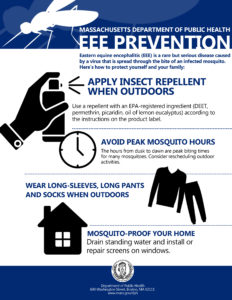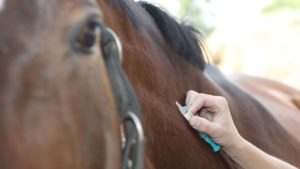Controlling Mosquitoes and Eastern Equine Encephalitis
An Integrated Mosquito Management (IMM) program is essential to helping prevent mosquito bites and transmission of serious vector diseases in the United States. As part of an effective IMM program, VDCI recommends a 4-pronged approach to target all phases of the mosquito’s life cycle.
1: Public Education
Mosquito control professionals can only do so much, and this is why we rely on a well-educated public in order to have a successful mosquito control program. Educating the public empowers people to take control of the mosquitoes breeding in their back yard and gives them the tools needed to reduce mosquito annoyance.
2: Surveillance
Surveillance allows us to detect mosquito species in a given area as well as any changes in populations. With this valuable data, we are able to more effectively time larvicide applications and more accurately target adulticide activities.
3: Larval Mosquito Control
Our trained field technicians inspect both known sources of standing water and any newly discovered sites for the presence of mosquito larvae. Eliminating mosquitoes prior to their becoming adults is an important element of controlling EEE and other mosquito-borne diseases because it stops mosquitoes before they acquire the virus and have the opportunity to transmit it to people.
4: Adult Mosquito Control
When necessary, adulticide applications are conducted with EPA-approved pesticides that are used in the safest and most environmentally sound way possible. Additionally, VDCI regularly tests adult mosquitoes and takes all appropriate measures to prevent them from developing resistance; thereby, minimizing the number of applications needed to control the population.
Treatment of EEE:
- There is no human vaccine for EEE or anti-viral drugs for treatment of EEE.
- For severe illnesses, supportive treatment includes hospitalization, IV fluids, and respiratory support. Patients with suspected EEE should be evaluated by a healthcare provider, appropriate serologic and other diagnostic tests ordered, and supportive treatment provided.
Their are vaccine for horses and check with your veterinarian if their are vaccines for other animals (like cats, dogs, etc…).
That is all it takes to protect your horse, a yearly vaccination!
Horses are the main victims of infection but disease can occur in various other mammals, including people and dogs. Canine infections are very rare and this can be considered an “oddball” infection. … As with EEE in horses, infected dogs pose no real risk to humans.
Veterinarians can test for WNV and EEE by submitting blood or tissue from an animal. Testing is available at the Massachusetts Department of Public Health during the mosquito season. Testing is rarely required for dogs and cats; horses, llamas and alpacas are the most commonly tested animals.
There is no reason to destroy an animal just because it has been infected with WNV or EEE virus. They do not increase the risk that anyone else will get sick. However, some animals, especially horses, llamas and alpacas, may become so severely ill that they cannot recover. Talk to your veterinarian to get medical advice for your particular animal.
Eastern Equine Encephalitis: A Rare but Serious Neuroinvasive Disease
![]() EEE is a rare but very serious disease that involves inflammation and swelling of the brain=Encephalitis, causing neuro symptoms. Fortunately, only 5% of human EEEV infections result in EEE. However, one out of three people who develop EEE will DIE, and many survivors have mild to severe brain damage.
EEE is a rare but very serious disease that involves inflammation and swelling of the brain=Encephalitis, causing neuro symptoms. Fortunately, only 5% of human EEEV infections result in EEE. However, one out of three people who develop EEE will DIE, and many survivors have mild to severe brain damage.
Of those who contract the EEE virus, the elderly (ages 50 and older) and young (ages 15 and younger) are at the greatest risk of developing encephalitis.
Eastern Equine Encephalitis and the United States
Between three and fifteen cases of EEE were reported every year in the U.S. from 2009 to 2018. Florida (13), Massachusetts (10), New York (8), North Carolina (7), and Michigan (7) reported the highest number of cases during this time period.

